By Susan Hiner, Guest Contributor
Mon Dieu! Still single at 25?!
If you were a young woman living in France at the turn of the twentieth century, on November 25th you might have received a number of friendly, encouraging messages by postcard—ranging from the anodyne “Bonne fête” to the more explicitly instructive, “Pray to Saint Catherine, and your wish will be granted” to the downright officious, “pay attention to what this handsome fellow says,” which we find on the verso of this card, admonishing the recipient to take heed of its printed message.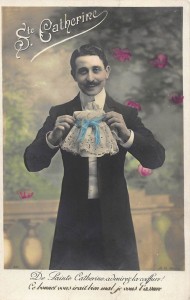 Don’t take the hat, the joli garçon apparently utters, take me instead! The gentleman offers his mustachioed self in lieu of the bonnet: a husband instead of a hat.
Don’t take the hat, the joli garçon apparently utters, take me instead! The gentleman offers his mustachioed self in lieu of the bonnet: a husband instead of a hat.
When I first began collecting catherinettes cards, little did I know that this frothy bonnet emblematized a cultural normalizing of female behavior. Or that those cards might eventually challenge that narrative. Indeed, in the first few decades of the twentieth century, young fashion workers would marshal the elements of the ritual into their own celebration of working women.
When girls reached the marriageable age of fifteen, they put order to their unruly girlish hair, donned the bonnet, and could then “coiffer Sainte Catherine,” meaning both wear the bonnet that signified their coming of age and create a bonnet to ornament the saint herself. They put their sewing skills to work and hoped to attract a husband as well.[1] While the origins of this tradition are to be found in religion and folklore, the mass appeal of postcards at the turn of the twentieth century and beyond was tied to technological advances in photography and printing and modernized mail systems. The folklore festival of Saint Catherine originally designated a rite of passage.
Saint Catherine was the patron saint of unwed girls, but also of old maids, their agin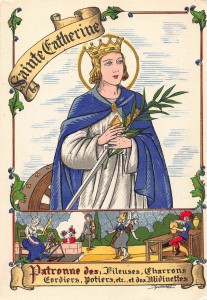 g corollaries. The endgame of Catherine and the bonnet ritual was thus either marriage or spinsterhood. Saint Catherine of Alexandria, who refused to marry the Roman emperor Maxentius, was condemned to death by the wheel. The (Catherine) wheel miraculously broke apart, and she was not harmed. She was, however, subsequently beheaded and thus martyred. The wheel is pictured in much of the iconography of the saint, which may account for her association with fashion workers.
g corollaries. The endgame of Catherine and the bonnet ritual was thus either marriage or spinsterhood. Saint Catherine of Alexandria, who refused to marry the Roman emperor Maxentius, was condemned to death by the wheel. The (Catherine) wheel miraculously broke apart, and she was not harmed. She was, however, subsequently beheaded and thus martyred. The wheel is pictured in much of the iconography of the saint, which may account for her association with fashion workers. 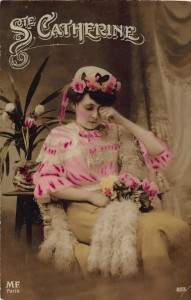
“Coiffing” Saint Catherine thus signified that a girl was eligible, but if she coiffed for too many years without bagging a husband, she was marginalized and doomed to spinsterhood. Woe unto the girl who has no such suitor as our mustachioed friend, for she was condemned to wear the bonnet and wait, as the weeping girl surrounded by her symbolic finery in this card suggests. Her tearful gesture conveys a distressing message of failure and impending solitude, for, as she ages, her chances of married bliss recede. After the age of twenty-five, celibacy would overtake eligibility, and girls could no longer don the coiffe.
The image of the bonnet was reproduced and circulated on a mass scale, demonstrating how the imperative to marry was 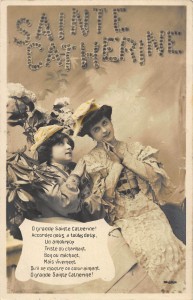 transmitted and reinforced at a time when more and more women were entering the workforce and questioning traditional roles.
transmitted and reinforced at a time when more and more women were entering the workforce and questioning traditional roles.
Beneath their quaint photos with their stylized poses featuring industrious, expectant girls and smiling, smarmy gentlemen, pithy rhymes, solemn prayers, and wedding day fantasies, these 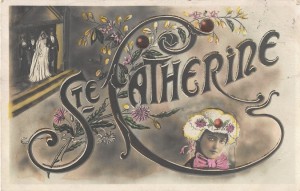 catherinettes cards screen a kind of social coercion into a rigid ideology that imposed marriage as the only acceptable pathway for young women to follow.
catherinettes cards screen a kind of social coercion into a rigid ideology that imposed marriage as the only acceptable pathway for young women to follow.
The bonnet even appeared to menace the girl on many cards as if threatening those girls who were not prioritizing marriage.
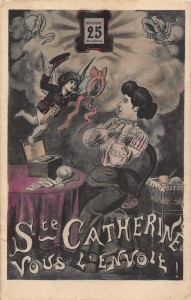 Sent by Saint Catherine herself, this card says, the diminutive messenger seems to take her quite by surprise, and brings with him an impending threat.
Sent by Saint Catherine herself, this card says, the diminutive messenger seems to take her quite by surprise, and brings with him an impending threat.
So hateful was the bonnet that some cards picture girls casting it off with unseemly gestures, perhaps to indicate that they no longer need Saint Catherine’s protection, having found a husband, or perhaps to indicate that they are throwing off the tradition and what it represents entirely. 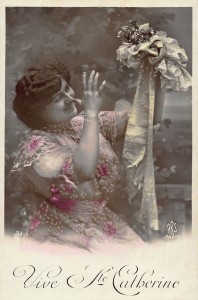
Beginning in the early twentieth century, after droves of provincial girls had left for Paris to enter the needle trades, Parisian fashion workers appropriated the November holiday as a celebration of women’s work in the millinery. The crafting of the hat itself became celebratory and the unwed status of the fashion worker a mark of pride when she wore a hat of her own creation.
A hat instead of a husband.
Susan Hiner is Professor of French at Vassar College. The author of Accessories to Modernity: Fashion and the Feminine in 19th-C France (Penn Press, 2010), she is currently working on a new book entitled “Behind the Seams: Fashion, Women, and Work in 19th-Century France.”
[1] For more on the history of this folklore tradition, see Yvonne Verdier, Façons de dire, façons de faire: la laveuse, la couturière, la cuisinière (Paris: Gallimard, 1979). The authority on the subject of the catherinettes is Anne Monjaret. See La Sainte-Catherine: Culture festive dans l’entreprise, preface by Martine Segalen (Paris: Editions du C.T.H.S., 1997).
